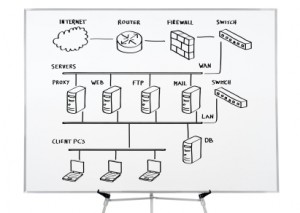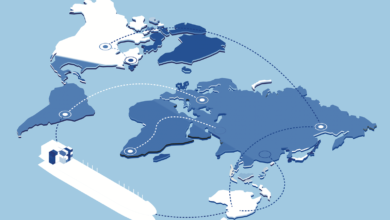ISO Network Standards as a Fundamental5 Support

ISO network standards protocols are crucial in computer networks to enable effective communication and interoperability. The International Organization for Standardization (ISO) is instrumental in developing and maintaining these standards. This article examines the importance of ISO network standards, analyzing their influence on networking globally.
The Definition of ISO Network Standards
The International Organization for Standardization has created ISO network standards as a comprehensive set of protocols and recommendations to enable effective, safe communication in various network scenarios. With these guidelines, devices and technologies used for networking are required to follow the same system which promotes compatibility and seamless interaction between them.
The Origin of ISO Network Standards
The origin of ISO network standards stems from the realization for a common tongue to be used in networking, especially when it started experiencing tremendous growth. During the latter part of the 20th century with an unprecedented global coverage, ISO stepped up and assumed accountability for developing a standardized structure that was not only universal but also adaptable across different locations and technologies.
Main Elements of ISO Network Standards
A range of essential network components, such as data transmission protocols, security measures and architecture are covered by ISO network standards. The all-inclusive nature of these guidelines ensure that a complete strategy is implemented for the development and upkeep of networks.
ISO 27001: A Vital Element in Securing Networks
ISO 27001 is a noteworthy standard within the ISO network, with its primary focus on information security management. In today’s world where cyber risks are prominent, this particular standard equips organizations with a strong foundation to protect their confidential data and improve their overall network safety measures.
ISO 9000 Series as a means to achieve interoperability
The target of ISO 9000 series is to improve the efficiency and effectiveness of network processes by emphasizing quality management systems. Adherence to these benchmarks ensures interoperability among diverse devices and systems, hence supporting a more cohesive and cooperative networking atmosphere for organizations.
ISO 14001: Incorporating Environmental Accountability into Networking- ISO Network Specifications Subsection 5
ISO 14001 serves as proof of an organization’s dedication to sustainability in a world that values environmental consciousness. By providing instructions on integrating eco-conscious strategies into network development, this standard guarantees that technological progress is ethically aligned with the environment.
Standardizing Network Protocols: ISO’s Contribution
ISO network standards prioritize the standardization of network protocols as a fundamental element. By doing so, they enable smooth device communication regardless of manufacturer and facilitate the development of a unified and comprehensive infrastructure.
Obstacles to Complying with the Regulations
Despite the significant advantages of complying with ISO network standards, organizations could encounter hurdles during implementation. These setbacks may involve initial expenses, reluctance to alter existing practices and a continuous requirement for adherence assessments. Nevertheless, in most cases, the long-term benefits surpass these obstacles.
ISO Standards – Heading 8: Emerging Trends and Evolving Network Standards
The networking landscape presents both challenges and opportunities that evolve with the advancements in technology. In order to address emerging trends such as 5G connectivity, artificial intelligence, and Internet of Things (IoT), ISO modifies its standards accordingly. By staying ahead of these developments, ISO network standards stay relevant and effective amidst a constantly changing digital environment.
ISO Network Standards Subheading: Improving Interoperability Across Nations with Shared Guidelines
International collaboration is facilitated by ISO network standards, which establish a universal platform for organizations across the world. Compliance with these norms enables enterprises to guarantee that their networking solutions meet international benchmarks and stimulate consistency in communication protocols and system interfaces. This synchronization holds particular importance in the case of multinational corporations and linked global networks.
Improving Networking Quality Assurance with ISO 9001
ISO 9001, which is a part of the ISO 9000 series, concentrates entirely on quality management systems. In networking scenarios, this particular standard highlights perpetual enhancement and fulfilling customer needs. The integration of ISO 9001 by organizations leads to streamlined network procedures that minimize inefficiencies while guaranteeing dependable and consistent user encounters.
Managing Risks in Network Operations: ISO 31000
The significance of maintaining a robust network infrastructure is well recognized, and ISO 31000 effectively deals with risk management for the same. With increasing complexities in networks, risks associated with vulnerabilities and threats rise as well. Therefore, organizations depend upon ISO 31000 to detect, evaluate and handle such dangers that arise from their network operations; prioritizing cybersecurity measures while ensuring overall stability within the system itself through proactive practices.
Emphasizing Occupational Health and Safety in Networking with ISO 18001
ISO 18001, although not explicitly linked to networking’s technical components, prioritizes occupational health and safety. For network operations, this guideline highlights the welfare of workers participating in designing, executing and sustaining a network structure. A secure work setting promotes enduring efficiency while also contributing towards triumphs within networking ventures as a whole.
Significance of ISO Certification in Networking
Achieving ISO certification in networking indicates a dedication to achieving excellence and complying with internationally accepted norms. This form of certification can boost an organization’s standing and competitiveness within the market. Clients, collaborators, as well as stakeholders typically perceive firms that are ISO certified as dependable and credible—emphasizing even more the significance of these network standards amidst current business conditions.
Training and Education for ISO Compliance
Educational initiatives and training programs are instrumental in promoting the widespread adoption of ISO network standards. Companies prioritize educating their staff on the principles and practices prescribed by these standards, empowering them to implement compliant solutions effectively. This investment in education creates an environment that values innovation and continual progress within the industry.
Adapting to Technological Advancements
ISO network standards must keep pace with technological advances to meet the changing demands and possibilities. In response, the organization regularly reviews and revises its criteria to integrate new tech developments effectively. This ensures that ISO network standards remain up-to-date and effective in light of emerging networking landscapes like edge computing integration or decentralized networks’ proliferation.
In Conclusion
The ISO network standards are evidence of the impact standardized frameworks have on molding networking’s future. These standards offer a detailed roadmap for businesses to navigate digital age complexities and address environmental and occupational health concerns, while ensuring quality and security. Complying with these benchmarks not only creates an optimistic outlook within the industry but also sets up a secure, sustainable global network ecosystem that is highly connected.





Thank you for your sharing. I am worried that I lack creative ideas. It is your article that makes me full of hope. Thank you. But, I have a question, can you help me?